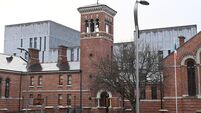Guardians with a cross to bear
Soon afterwards, experts in the National Museum became aware of the theft of the unique object and attempts to sell it abroad.
It turned up in the Getty Museum in Malibu, California, and the sellers were looking for $1.75m. The National Museum took civil proceedings against the people who had found the object and secured its return.
In 1991, one of the finders, Joseph Mulvey, was fined £10 (12.70) for failing to report its discovery.
Since its return, State conservationists have been working tirelessly to restore it.
“It was in its constituent parts, so we had to reassemble it, clean it and restore it,” said Rolly Read, head of conservation at the National Museum.
He said the importance of the object lay in the belief that the stone crosses dotted around the country were first modelled on a metal form.
“This is the first time we’ve found a processional cross that the other crosses were based on. It was gilded in silver and gold. Now, it looks like it was made from bronze.”
Mr Read was loathe to put a value on the cross, now it has been restored, but said it was worth much more than the asking price in the Getty Museum. The cross, just under four feet long, will go on display in the coming months in the treasury of the National Museum in Kildare House, along with the nation’s other priceless treasures.
“It will go along with the Ardagh Chalice, Derrynaflan (horde) and the Tara Brooch. It’s big league stuff and it looks amazing.” The recovery of the Tullylough Cross was a great success for the National Museum. But the case highlights the problem of the looting of sites by people for selfish gain.
The disappearance of the Tullylough Cross occurred during the height of
archaeological theft in Ireland following an upsurge in metal detection. Organised criminal gangs, often using metal detection associations as fronts, raided national monuments and sold their objects abroad, mainly in Britain. But their days were numbered.
In the 1980s, the Derrynaflan horde - containing early Christian liturgical objects - was taken from a site in Co Tipperary. Subsequent cases resulted in a supreme court ruling which said that under the Constitution these objects were the property of the State.
In 1994 the National Monuments Amendments Act was introduced, which made it illegal not to report the discovery of an object of antiquity and to possess it, thereby including both the person stealing the goods and those who received them.
The act also prohibited digging for archaeological objects and the use of metal detectors for such a purpose without a licence. Anyone convicted on indictment under the act faces a minimum of five years in jail and/or 10,270 fine.
“There was a fall-off after 1994 of the looting of sites,” said Ned Kelly, head of the Irish antiquities division
of the National Museum and expert on the area. However, in recent times, there are signs of the re-emergence of the problem.
“There are new groups of people and individuals targeting sites with a view to removing valuable objects for sale,” said Mr Kelly.
There are some 250,000 sites protected under the register of national monuments, many hiding important and valuable items, such as coins, bracelets, crosses and stone carvings.
“We have the biggest number of monuments in western Europe,” said Mr Kelly. “We view this as extremely serious, because not only are they taking the object, but the looting is also detrimental to information.
“When you remove an object, you take it out of its context. Say, if it is coins, that might date the site. A site without it’s archaeological content is of little use.” He said unlike the 1980s and early 1990s, no one would now be unaware it was against the law to dig for antiquities. He said the crime was now more covert and that thieves were using the internet to sell their objects.
“There are certain parts of the internet, like private chat rooms, that we have been excluded from, that we believe they are using.”
He said a number of important pieces still missing, including a sheelagh-na-gig erotic stone carving taken from Kiltinan, Co Tipperary, in 1990 and a stone head taken from Dingle peninsula in the mid 1990s..
He said the museum had wide contacts with dealers and museums here and abroad and monitored what was on sale. He also said the setting up of a dedicated art and antiques unit in the National Bureau of Criminal Investigation was a major development in addressing the problem.
With so many sites in the country he said it is impossible to guard them all. So instead they target the thieves in conjunction with the NBCI.
“This is a democratic issue. This is the people’s heritage and it is being ripped off by unscrupulous, selfish, self-serving people,” said Mr Kelly.












